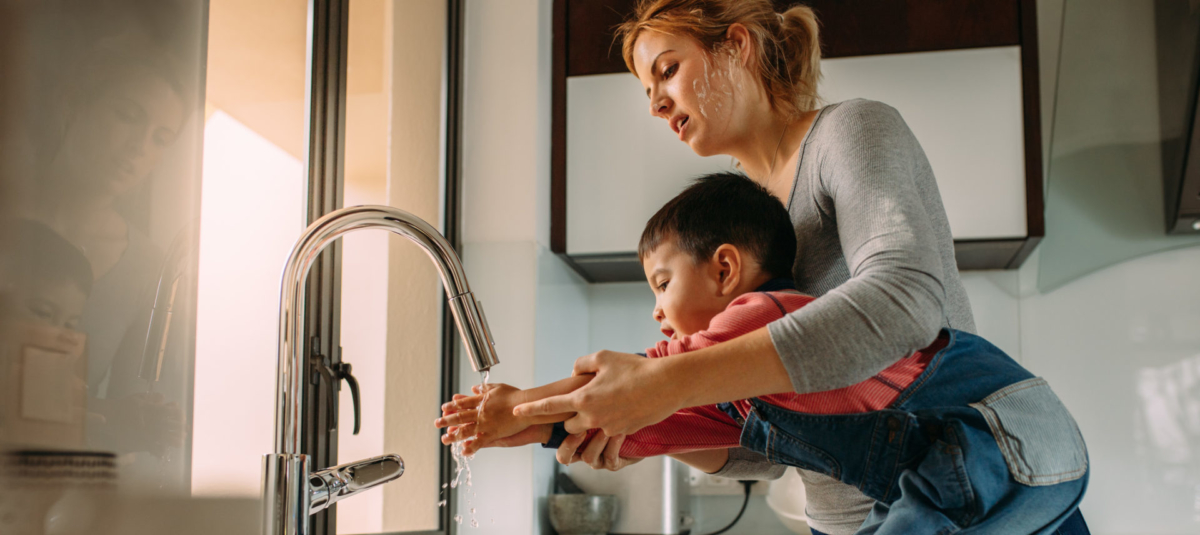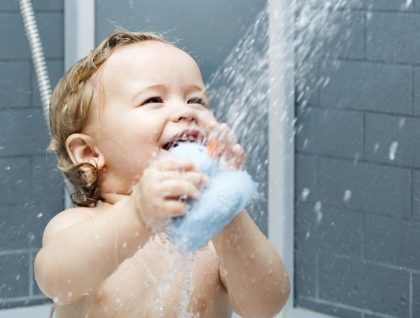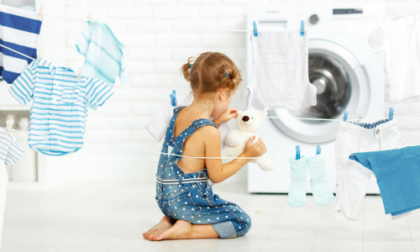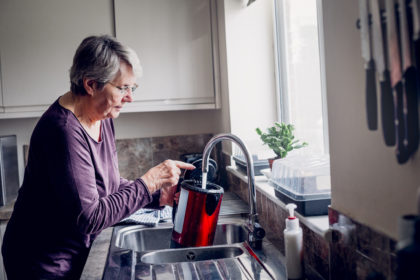Save Water at Home

Everyday tasks like washing dishes, taking showers, doing laundry, and washing the car can add up to several thousand gallons of water used each month. Conserving the amount of water used in your home may keep your water bill lower and is also better for the environment. When you save water, you leave more for salmon and other wildlife. Here are several tips and tricks you can use to reduce your water consumption. Once you make these practices a habit, you’ll be surprised at just how much water you can save.
Tacoma Water customers can use our easy online form to request free efficient showerheads, faucet aerators, hose spray nozzles, and more.
- Save in the Bathroom
-

The largest water usage occurs in bathrooms and can account for more than half of all the water your household uses, according to the Environmental Protection Agency.
Install low-flow fixtures
- Water Efficient Showerheads
By replacing just one showerhead with a WaterSense labeled model, the EPA estimates the average family can save 2,900 gallons of water, the amount of electricity needed to power its home for 13 days, and more than $70 in energy and water costs every year. - Low-Flow Aerators
Easy to install, aerators screw under the bottom of your faucet to reduce the water flow without reducing the pressure. Faucets with aerators can use as little as 0.5 gallons of water per minute, while typical faucets without aerators use 2.5 to 7 gallons per minute. An efficient faucet using 0.5 gallons per minute will cost you 80 cents per month, while a standard faucet using 2.5 gallons per minute can cost you $3.99 per month. - Free for Tacoma Water customers
Tacoma Water customers can use our easy online form to request efficient showerheads, aerators, and leak detector dye tablets for your toilets – all free of charge. We can also offer consult via phone or video chat to generate a customized list of efficiency suggestions for your home. Contact us at 253-502-8723 or conservation@cityoftacoma.org to learn more.
Take a shower instead of a bath
Taking a shower uses much less water than filling up a bathtub. A five to 10-minute shower uses 10 to 25 gallons, while a bath takes up to 70 gallons! If you do take a bath, be sure to plug the drain right away and adjust the temperature as you fill the tub.
Take shorter showers
Keep your shower under five minutes long. The average shower is about eight minutes. By shortening that to five minutes, you can reduce the amount of water that you use by nearly one-third, or roughly 10 gallons per day!
Put a bucket in the shower while the water is heating up
Most people wait a minute or two for the shower to heat up before getting in. Put a bucket in the shower to capture that water and use that to water your household plants.
Turn off water when you brush your teeth or shave
There is no need to keep the water running while brushing your teeth or shaving. When brushing teeth, wet your brush and fill a glass for rinsing your mouth out when you are done. For shaving, fill the sink with a few inches of warm water to rinse the shaver.
Check for leaky toilets
A silent toilet leak, often caused by a flapper that does not completely close, can waste 50 to 500 gallons of water per day. A silent toilet leak that wastes 250 gallons of water per day would cost a City of Tacoma resident more than $50 per month in water and sewer charges.
For more information on how to check for leaky toilets, click here.
Install high-efficiency toilets
High-efficiency toilets use 1.28 gallons of water or less per flush, while older models use between 3.5 and 7 gallons per flush. The average household could save up to 2,400 gallons per month by replacing an older toilet with a newer, efficient model.
How good is your toilet? Here’s the average cost per month for several options:
- High efficiency, 1.28 gallons or less per flush: $3.77
- Standard, 1.6 gallons per flush: $4.71
- Model from 1980-1994, 3.5 gallons per flush: $10.30
- Model from 1950-1980, 5 gallons per flush: $14.71
When shopping, look for the WaterSense label to pick the most efficient and most functional models.
Flush smart
Avoid using the toilet as a trash can. Every time you flush the toilet, five to seven gallons of water is used (older toilets). Low flow toilets typically use 1 – 2 gallons/flush.
Replace your toilet flapper once per year
Flapper valves can rust or break quite quickly causing unnecessary leakage. It’s recommended that you replace them once a year even if they are good for longer.
- Water Efficient Showerheads
- Save in the Laundry Room
-

The average American family washes about 300 loads of laundry each year. Laundry rooms use more water than any other room in the home after bathrooms.
It’s estimated that there are 76 million top-loading washers still in use across the country and 25 million of those are more than 10 years old. Washers built before 2003 are significantly less efficient than newer models. These inefficient washers cost consumers $2.9 billion each year in energy and water. If you have a standard clothes washer that is over 10 years old, it’s costing you, on average $210 a year.
When it is time to replace your washer, consider purchasing an ENERGY STAR certified front-loading washer. These washers use about 25% less energy and 45% less water than regular washers.
In addition to using energy efficient washers, there are also other simple ways to help save in the laundry room.
- Set your washing machine to use cold water rather than hot or warm water
- Reuse shower towels. You don’t need to use a new clean towel for every shower you take. You are clean when you get out of the shower. After drying off, just hang your towel up to dry. It will be completely dry before you need it again.
- Only use the washing machine for big loads. Don’t let a small pile of dirty laundry make you feel overwhelmed. Wait until you get a big pile that you can wash at once.
- Use size cycles – when you need to run a small load, take advantage of the washer’s “small load” option/setting, which uses less water because it is washing fewer items.
- Just say no the extra rinse cycle – if your washer gives you the option to run an extra rinse cycle, skip this step to save water.
- Upgrade to an energy-efficient hot water heater. Similar to your washer, when the time comes to replace your water heater, choose an efficient model. The cost savings of using an efficient water heater will make the purchase worthwhile, not to mention you may be eligible for government rebates for tankless and solar units.
- Save in the Kitchen
-

The kitchen is a great place to start making changes in your daily routine to save water. Follow these tips and whip up a batch of water savings.
- Install a high-efficiency kitchen faucet aerator. Kitchen faucets with aerators use 1.0 to 2.5 gallons of water per minute compared to older faucets or faucets without aerators that use up to 7 gallons.
- Don’t let your water run. Turn off the tap when not in use.
- Fill your sink with soap and water, instead of running water, when washing dishes by hand.
- Keep a pitcher of water in the fridge to prevent running your faucet until water is cold.
- Scrape dishes instead of rinsing before putting them in the dishwasher.
- Fill your dishwasher to capacity before running it.
- Thaw food in the refrigerator overnight rather than using a running tap of water.
- Add food wastes to your compost pile or brown curbside food/yard waste bin, if one is provided by your city, instead of using the garbage disposal.
- Install an Energy Star dishwasher. They use less than 3.5 gallons of water per cycle compared to standard dishwashers, which can use up to 14 gallons.

